Home
KASHBA Asiatica
Ais Loupatty
Ton Lankreijer
Staalstraat 6
1011 JL Amsterdam
Open 12:00 – 17:00
Zondag / Sunday 14:00 - 17:00
GESLOTEN / CLOSED
16 okt - 5 nov '25
Contact:
31-20 - 6 23 55 64
06 - 588 41 370
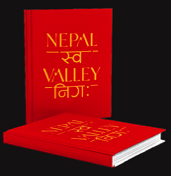
Within two months, most of his interior was on display at an auction house outside the city; his children indeed had no interest in it. Much of his collection was depicted on the website.Strange, how bloodless the objects suddenly seemed. Soulless.
It reminded me of a photo book about British crown jewels that I once leafed through. In chronological order, paintings and photographs showed the same crown, bracelet, or brooch through the centuries. The jewelry remained undiminished while its wearers were replaced by descendants — as if they were new wallpaper.
A friend went to the auction viewing day to see if the pot was there – but unfortunately it wasn't. Perhaps one of the grandchildren was more interested than expected or wanted a memento of their grandfather.
With the passing of every human being, a museum closes, even if it was sometimes only open on Wednesday afternoons - after three o'clock.
As a twelve-year-old child, he fled Nazi Germany with his mother and slightly older brother, partly on foot. Exhausted and displaced, they knocked on the door of their wealthy family in the Netherlands, but because of her marriage to a young German doctor of theoretical physics, the family had become ‘tainted’.
-'I'm amazed you don't have a trace of a German accent anymore,' I once remarked.
'It was beaten out of me in the schoolyard.'
Confluence
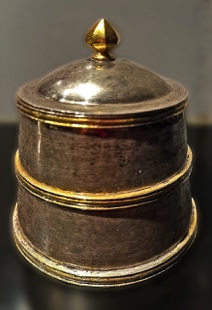
In the 1990s, I bought a small, old jar in Kathmandu that was clearly once made in Tibet. It may have been carried over the Himalayas by a trading caravan.
Perhaps it belonged to a nomadic family's foldable altar that they carried with them as they roamed the icy plateau.
Or maybe it came with Buddhist monks who fled the Red Guard invasion in the 1950s.
What made the jar so charming and authentic was that it had the same style as Tibetan houses and monastery temples: tapering upwards from the foundation.
This gives the structure a firm footing on the road while the door and window frames elegantly converge towards each other.
Perhaps this is intended to achieve a better distribution of weight. The house seems to be bracing itself for an icy storm.
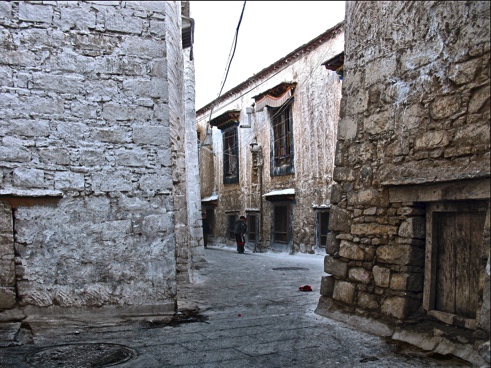
The jar was made of hammered silver and had a similar shape. Three rings ran across it, which, like the top, were fire-gilded. In all its simplicity, the little treasure was as perfect as it was practical.
No idea what it was intended for – once in use, every box, bowl or pot fills itself.
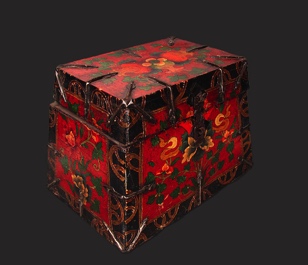
We had hardly finished unpacking the shipment, when an elderly friend placed his hand on it and said, ‘This one is for me.’
I was familiar with his fondness for small silver objects, having visited his home. He had even had a display case built along the wall for them. This suited the fragile Empire-style furniture, the large carpets, the statues and figurines—in short, it suited him.
When they visited him, the children would say, 'We're going to Palace 't Loo.’
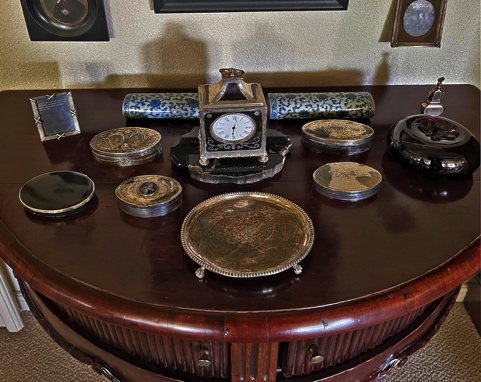
After two marriages, he decided he was unfit for marriage.
I could understand that. If you moved a thing on his table or mantelpiece while he was making coffee, he would thoughtlessly put it back when he returned – everything had its place and had to stay there.
As he grew older, he sometimes asked me to buy back items. ‘Even my grandchildren have no interest in them.’
The last time he called me to come over — he was leaving the house less and less — he asked me to select items from his living room that 'you might still be able to do some business with’.
That was anything but easy for me. With great reluctance, I opened the display case and placed a few objects hesitantly on the coffee table around the Tibetan jar, which was still there. It felt as if I were prying open his diminished world and tearing pieces of wallpaper off the wall.
A moment later, the little jar had been quietly removed.
I laughed and looked at him sideways.
‘Surely I can keep something?’
- 'You can keep all you want, of course,’ I tried to call off the sale.
'No, no. The children have no interest in any of it.’ He gestured around the room: at the paintings, furniture, antique clock, graceful figurines and all the silver items.
- ‘But that doesn't mean you have to live on orange crates,’ I charged. ‘Here is a magnificent collection. As an heir, you would wish to be punished with it.
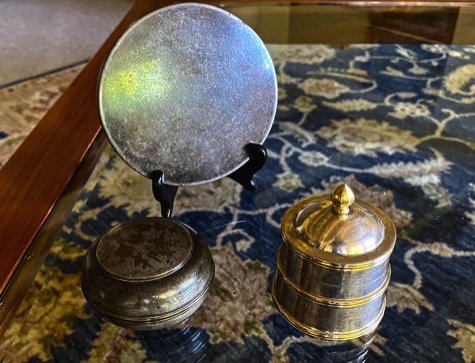
He lit yet another cigarette. “I'm fed up with it all. I don't want any more of this.” Restlessly, he waved his hand with the burning cigarette in the air. I didn't know him like this. Nervously fidgeting and constantly shifting position – but nervous about what?
His restlessness was contagious and I just wanted to leave. Or was it slight panic on my part, given how bad I am at comforting people? It would definitely not have been appropriate to put my arm around him; he would have shrunk away immediately. But to encourage an 88-year-old man to endure his lonely day, I just couldn’t find the words.
‘At times like that, you don't need to say anything,’ a psychologist friend later commented, ‘you just need to listen.’
Indeed, it was better to remain silent. If life became unbearable, I would opt for Drion's pill – if I could get hold of it, that is.
“The doctors at the AMC say I have early-stage Alzheimer's.” He looked at me intently. He was clearly expecting a reaction. Better yet: a clear reaction.
“Do you think so too?” My voice sounded as trite as the cliché itself.
"They say so! The doctors say so!"
His emphatic intonation confused me. Did that mean it had to be true, or had they never should have told him?
“I haven’t noticed anything,” I lied.
However, the diagnosis might well be correct.
As in previous years, he left the resale entirely to me. Each time, I only deducted the VAT that I had already paid to the tax authorities. It was simply a favour for a friend.
Much to my surprise, we were unable to reach an agreement this time. “Unacceptable!” he texted in response to my calculation.
'I'd rather do nothing. Bring everything back.' His estimate was no less than three times higher than any achievable sale price.
To my last New Year's greeting, he responded with a text message: 'I was planning to deliver all my greetings in person, but this old body has other ideas!!! Please be patient a little longer……’
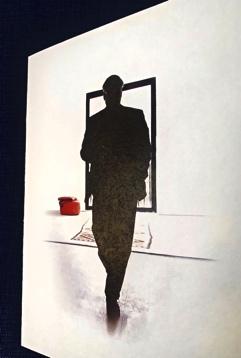
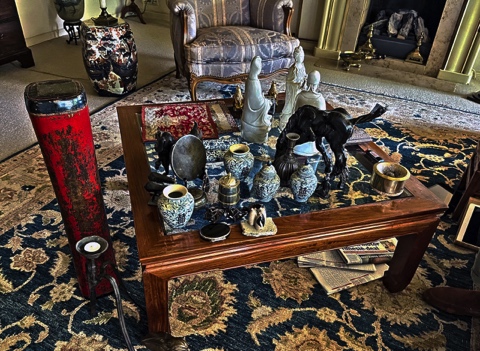
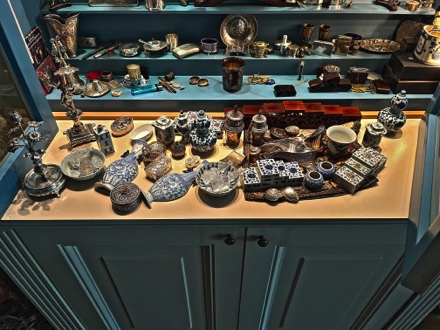
One month later,
a mourning card arrived in the post.
On the front was a photo that I had taken myself at the opening of an art exhibition.
A week after that, Pemba comes over for tea again – hot water for him – and brings the little jar with him.
Without being asked, he explains that the monks put rice grains in the bottom part and barley in the upper. During rituals, they take some with their thumb and forefinger and – he makes the accompanying gesture and sound – scatter it around while murmuring.
Perhaps he has discussed it with his fellow brothers, wondering about my interest.
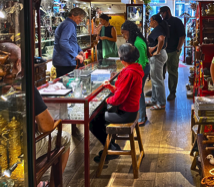
Another two months later, Pemba walks in again.
He is a former monk who fled Tibet in the 1970s.
For six years, he worked as a dishwasher in a Chinese restaurant kitchen.
Until he obtained a residence permit and dared to move around freely.
He asks me if I would perform a silver test for him.
‘Of course, but I will teach you how to do it and order the test for you. Where is it?’
He takes a package out of his bag and unfolds the rice paper.
A short cry of surprise escapes me. Ais looks up and reacts in the same way. Pemba is startled. Was he in the wrong?
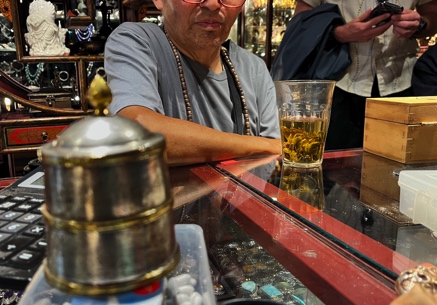

-'Look! The Tibetan pot! Oh, I can tell you right away that it's made of good silver. But where did you get it?
‘Bought it at thrift shop.’
- 'Huh?', we retort in disbelief.
‘In Bussum.'
- ‘Pardon?’
I know he regularly scours villages in Zeeland and North Holland in search of old blood coral, but why would he end up in Bussum for this?
He laughs and shrugs his shoulders:
‘Why not?'
The Hilversum auction house apparently failed to appreciate the value of the Tibetan pot. Distracted by the gold-plated rings, they may not have noticed that it was made of silver. Immediately after its rejection on bringing it in, I suppose the family members drove straight to the Bussum thrift shop.
With a hint of pride, Pemba holds up three fingers. 'Three euros!'
Oh no, I think at once, it'll be hard for him to sell it to me now.
'I'll give you ten,' someone in the shop immediately calls out – indeed, that's what I mean.
Pemba looks at him somewhat shyly, the deadlock now also dawning on him.
-'I'm glad it ended up with him,' I silence the brash bidder. 'At least now it won't end up as a pepper and salt shaker in some kitchen in Bussum. But Pemba, you sell it, please, tell me your price.’
He nods, but I notice him thinking: at what cost?
Then, he puts a graceful spin on it.
'Maybe exchange?’
- ‘Great! Good idea.’
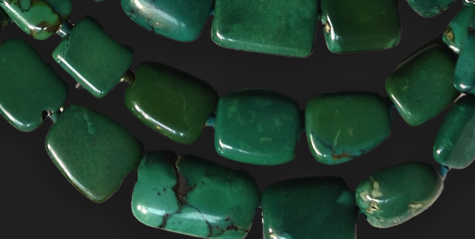
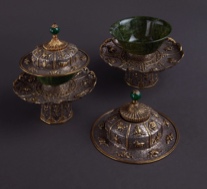
A few weeks later, Pemba walks in again.
Other former refugees have sent him, I suspect, to enquire about the price of a set of Tibetan teacups.
I bought them in Nepal in the 1990s. Once these kinds of items leave the shop, they seem to become antiques on the doorstep.
The other Tibetans in Pemba's group assume that he, being naturally sympathetic, will be able to negotiate a better price.
- ‘Those teacups are made of good silver. Just like your small jar,’ I add casually.
‘You mean small jar? You want?’ he counters.
- ‘Exchange for what?’
‘You have Tibetan beads, old turquoise?’
Ah, you've thought this through, I laugh inside. This way, you let me set the price myself – down to the gram.
- ‘Okay.’
You wonder how the smooth bands between the gilded rings remained unscathed. Perhaps it was also a kind of salt shaker for the monks – not for use in the kitchen, but on the altar.
It's in my home now - until the day the wallpaper behind it changes, I guess.

I cannot explain to him what the jar reminds me of, what it symbolises to me. I know of no other religious culture in which monks were so inventive in devising ritual trinkets and knick-knacks during their many idle hours. Their imaginative religious paraphernalia are invariably larded with symbols that emphasise their spiritual function.
24 sept 2025
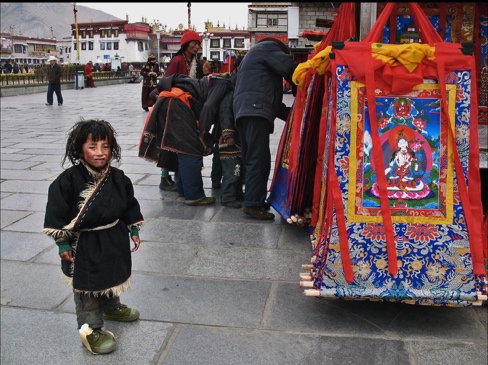
Also thangka-paintings take on a similar shape.

